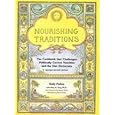
I love the cookbook Nourishing Traditions, but as I was re-reading it one night lately, I remembered a social engagement I had been invited to a few years ago by an acquaintance. This acquaintance was a whole food and traditional foods junkie. She was out to get more people to join her food religion and had set out a spread of traditional whole foods for a group of us to try. To swing us over to her side, she had chosen to start with desserts and sweets and before us was a vast array of things ranging from pumpkin pies, puddings, muffins and cakes. We were drooling at the mouth when we saw all this food and I, for one, was excited at the prospect of possibly, for the first time ever, finding a healthy dessert.
The first thing I remember about this night was the color of the food. Surprisingly there weren't any lively colors, and puzzling that it all seemed to be of the same brown hue. There were also little tincture bottles strewn about on the table full of things we were unsure about. And then we tasted the food. Literally quite... tasteless. It was such a disappointment. (I knew then why her husband was a closet fast-food fanatic.) I also remember thinking that if that is what traditional, whole food, organic-fermenting-raw-eating meant, I wanted nothing to do with it.
I think taste is important in food. We have been endowed with taste buds by our Creator for a reason. To eat and savor food has to be one of our most pleasurable sensations. Sure, I can acknowledge that there are times I eat certain foods that are nourishing, but are not exactly tasty because I know I need that particular thing (maybe not the best example, but plain yogurt comes to mind --I don't like the taste of dairy, but I know that good digestive enzymes and the live cultures are important to me). But by and far, food should never be unpalatable, but instead exciting, exhilarating, bursting with flavor, tender or crispy, sweet or spicy, saucy or silky.
Marc David in Nourishing Wisdom tells about a experiment with rats who were deprived of their taste sensation. Even though these rats were fed a conventional rat diet, the taste-deprived rats soon died and autopsies revealed only one cause of death - malnutrition. He surmises that to be "fully nourished by food, we must experience it through tasting and chewing."
Good, nourishing, traditional, real food does not have to be bland, colorless, and tasteless! If only that gal had instead brought out a gorgeous salad, full of delectable lettuces, with red, bursting strawberries that were overflowing on the plate, with cooked, chopped home grown chicken and farm fresh eggs, and deep green sliced avocado, that not only looked good, but tasted and smelled good....then I would have fallen in love right then and there with this new food religion, instead of taking me years to finally get it. Whole foods are real foods, foods that come right out of your yard and mostly with little change before eating.
This is the dessert she should have served us--simple, whole, and your taste buds will thank you:
FRIED BANANAS WITH HONEY (adapted from Sally Fallon's Nourishing Traditions cookbook)
8 very ripe large plantain bananas or 16 small red bananas
1/2 c extra virgin olive oil
1 c fresh orange juice
1/3 c honey
1 t cinnamon
Peel bananas and cut lengthwise. Saute in batches in oil, transferring with a slotted spoon to an oblong dish. Make a mixture of orange juice, honey and cinnamon. Pour over bananas and bake at 300 degrees for about 15 minutes. Can serve in bowls with a dollop of cultured cream.

No comments:
Post a Comment